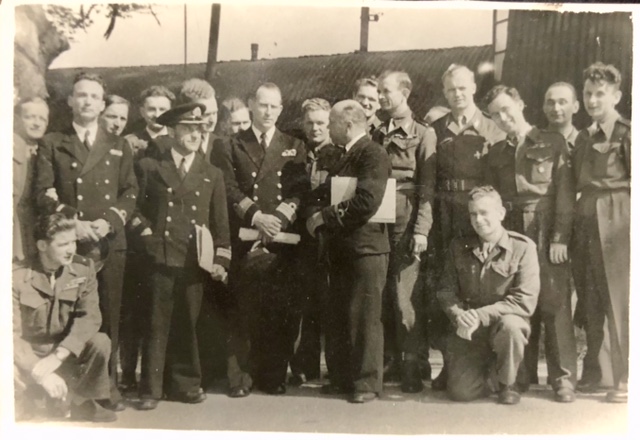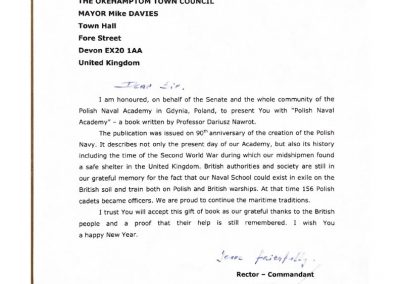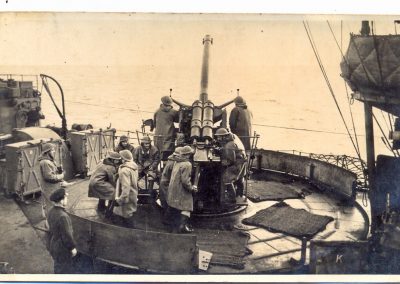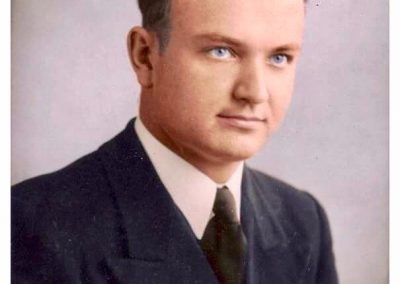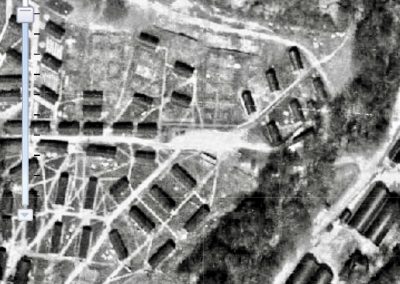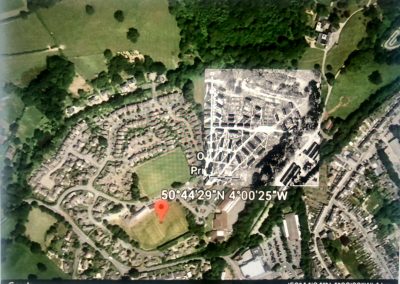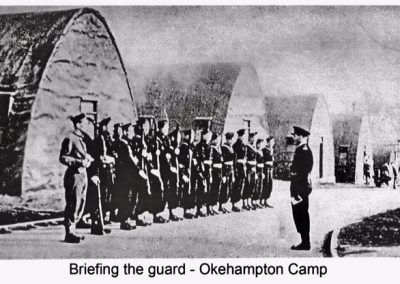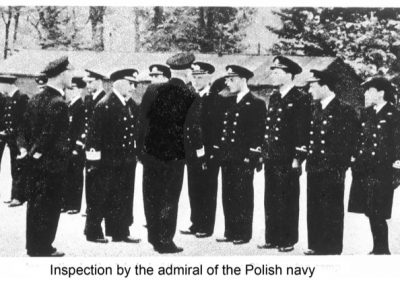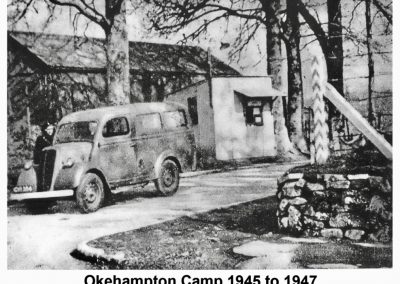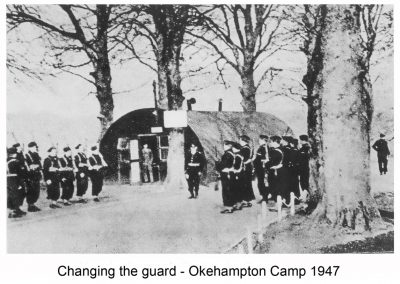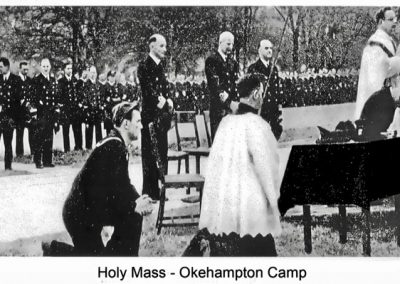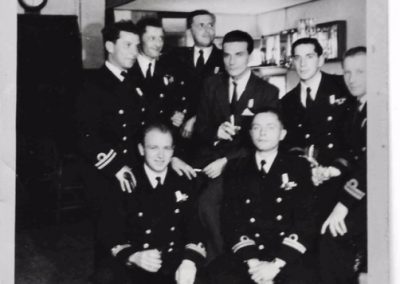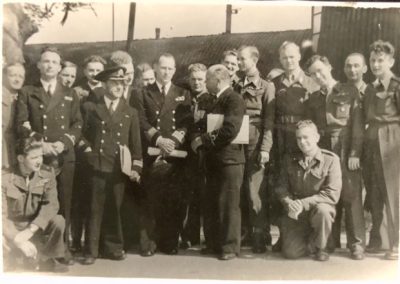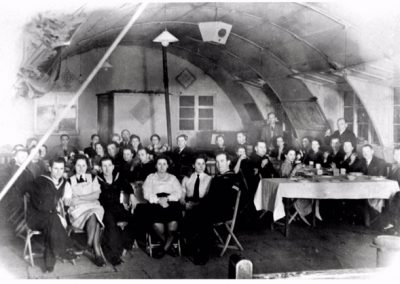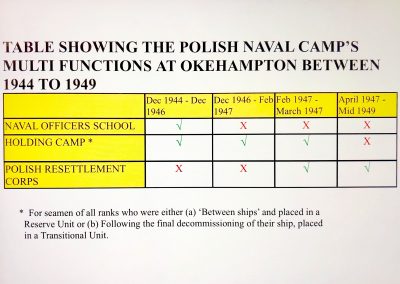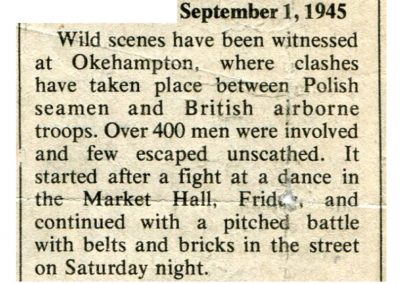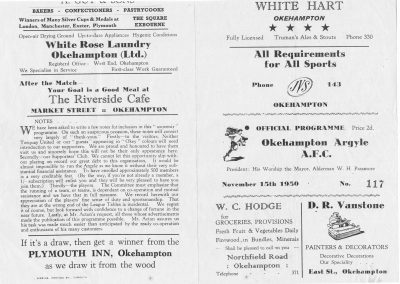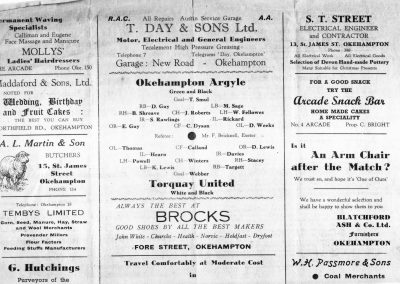This summary has been prepared by Jolanta Wilson, lead researcher on the Polish Naval Camp in Okehampton, with additional research support from Peter Szypko and Antoni Olszowski. To view larger images, please click on the thumbnails.
INTRODUCTION
The Polish community in Okehampton is now well established. The majority of Polish people who live and work here arrived after Poland joined the European Union in 2004.
However, this was not the first time Polish nationals were welcomed to Okehampton.
My aim has been to uncover the history of the Poles who came to Okehampton during the Second World War, when the town became a home to the Polish Navy.
RESEARCH PROCESS
The starting point for my research was a book written by Professor Dariusz Nawrot and published in 2012, entitled: The Polish Naval Academy. It was published to mark the 90th anniversary year of the Academy. An extract, translated from the Polish, is available.
A copy of the book was presented to the Rev. Mike Davies, the Mayor of Okehampton at the time, and is now held in the Town Hall. It might have been a little surprising for a small market town in the heart of Devon to receive such a gift from Poland. However, this gift was due to Okehampton town’s historic link with the Polish Navy, particularly the Naval Academy; the town played a vital role in hosting the Polish Navy and the Polish Naval Warrant Officers School over 75 years ago.
-

The letter accompanying the book 'The Polish Naval Academy' by Professor Dariusz Nawrot held by Okehampton Town Council
In the letter to the Mayor of Okehampton which accompanied the gift, Rector Commandant Czesław Dyrcz, speaking on behalf of the Polish Senate and the Polish Naval Academy, expressed his gratitude to the British authorities and wider society for hosting the Polish Navy during WW2, during which time the Naval Warrant Officers School found a safe haven in the United Kingdom and 156 Polish Cadets become officers.
My fellow researcher Tony Olszowski established contact with Professor Dariusz Nawrot regarding the use of his book as an inspiration for the research.
In a reply dated the 20th October 2020, Professor Dariusz Nawrot congratulated us on our project and on raising awareness of the history of the Polish Naval Camp in Okehampton.
Through my research (which has drawn particularly on Professor Nawrot’s historical account) I have assembled the following summary.
WHY DID THE POLISH NAVY COME TO BRITAIN?
After Poland was invaded by Germany and the Soviet Union in 1939, seven ships from the Polish Navy managed to escape and eventually arrived in Britain. The Anglo-Polish agreement signed on the 18th November 1939, established the role of the Polish Naval Department in Great Britain. This agreement outlined that the Polish Navy in exile would continue to fight while embedded within the Royal Navy, but under their own command and ship’s officers, and flying the Polish flag.
The photograph below is a typical record of life on a ship for the Polish Naval crew.
Based on this agreement, only five days later, on the 23rd November 1939, the Naval Warrant Officers School in exile was set up in the British naval base at Devonport, in Plymouth.
THE NAVAL WARRANT OFFICERS SCHOOL
The School was essential to the Polish Navy, enabling the completion of training of those cadets who had begun their education back home and training new officers who would serve on both Polish and British ships.
The School was founded and located on board ORP Gdynia, former s/s Kościuszko, a ship leased from the Polish Merchant Navy. It was a 6-deck unit which could accommodate up to 800 people and it was moored in Devonport, Plymouth. ORP Gdynia was designated as the main base of the Polish Navy in Great Britain.
First to walk on board ORP Gdynia on the 23rd November 1939 were the young Officer cadets who were at sea undertaking their maritime internship aboard ORP Wilja and ORP Iskra when the war broke out. This meant that they were unable to return home and eventually found their way to Great Britain.
Among the cadets who boarded ORP Gdynia that day was Stanisław Olszowski, pictured below.
Prof Nawrot writes:
“From the first days of its inception in exile the Naval Warrant Officer School received kindness and far-reaching help from the highest state authorities of Poland and Great Britain.
This was reflected, among other things by the visit of King George VI on the 16th December 1939 and by the First Lord of Admiralty Winston Churchill on the 15th February 1940.
During their visits, the distinguished guests showed a keen interest in the lives of cadets.”
The main emphasis of the military programme of the Naval Warrant Officers School was placed on practical training onboard ships.
In 1941 the Warrant Officers School was moved to the buildings on Stoke Terrace in Devonport, which came to be called the ‘Polish Naval Barracks’. This building witnessed the first ever promotion ceremony to the Officer rank of the graduates from the Naval Warrant Officers School in Great Britain. Tony Olszowski’s father, Stanisław Olszowski was amongst those who were commissioned that day, being promoted to Sub Lieutenant.
Some of those young Officers, like Tony’s father, eventually became teachers themselves, training the new Officer cadres, and sharing their experiences and knowledge.
THE MOVE TO BICKLEIGH
By the autumn of 1943, the number of cadets training at the Naval Warrant Officers School, and also Officers, had decreased dramatically.
To remedy the situation, the Naval Warrant Officers School was moved to the Navy Training Camp at Bickleigh near Plymouth with a programme to encourage wider naval personnel to apply to train as Officers. The Warrant School was based there from September 1943. The numbers of personnel enlisting at the Naval Training Camp at Bickleigh Camp gradually increased, as Polish Army and Navy Officers and prisoners were freed from captivity by the Allied army as they advanced across occupied Europe.
THE MOVE TO OKEHAMPTON
In December 1944 the Polish Naval Camp and the Polish Naval Warrant Officer School were moved again to Okehampton, which became their final destination in the UK.
ORP Bałtyk Polish Naval Training Camp was situated just off Lodge Hill. The Camp covered the area where the Rugby Club and Primary School are at present, and the large field in front of Oaklands House.

Oaklands House (Peter Szypko collection)
Oaklands House and the estate belonged to George Gratton, the then wartime Mayor of Okehampton. The house still stands, and is now partly used as a pet care store whilst the rest of the building has been converted into flats.
During the war, the land in Oaklands Drive and the field were requisitioned for the war effort. A motor transport depot was established and a mixture of Nissen or wooden huts for accommodation were erected – for first the American troops and later for the Polish Navy.
American troops occupied the Camp from May 1943 till June 1944 in preparation for D Day.
In December 1944 Polish Navy then moved onto the vacated site. Until 1947, the site acted as a training camp. Thereafter, it became a Resettlement Centre, remaining in operation until 1949.
THE SHAPE AND LOCATION OF THE CAMP
Able Seaman Aleksander Szypko was one of the people who trained there and served in the Polish Navy during WW2 with distinction. He is posing here in a field on the grounds of the Polish Naval Training Camp at Okehampton around October 1946 following his demobilisation. Oaklands House can be seen in the distance.
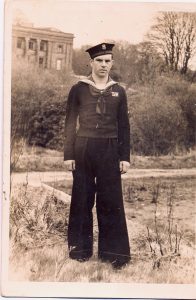
Aleksander Szypko (Peter Szypko collection)
Below, on the left is an Historic England aerial view of the northern half of the ORP Bałtyk Polish Naval Camp from the 1940s. On the right, the Google map showing the present Okehampton Rugby Ground and the surrounding area where the ORP Bałtyk was located, with the superimposed image of the Historic England arial view, to enable comparison of the two areas.
-

A picture of an original aerial view of the northern half of the camp from Historic England (Peter Szypko collection)
-

A superimposed version of the historic view of the northern half of the camp, set against a present-day modern map of the area (Jolanta Wilson collection)
The Rugby Ground (marked with a red marker), was the site of the main parade area for the camp. Photographs from the time indicate that the area was used not only for parades and drills but for other gatherings such as open-air masses. Army Nissen huts and other buildings marking the living quarters stretched in all directions from the central parade area.
The historic map covers the northern half of the camp (where the present day primary school sports pitch is) and the large field between the school premises and the area just in front of Oaklands House, which is visible here in the top right hand corner.
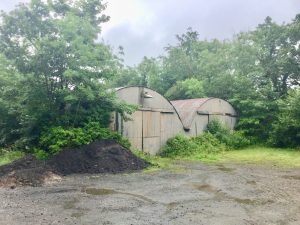
The remaining Nissen huts, as they stand today (Peter Szypko collection)
The historic map shows at least 50 Nissen huts in the area designated for living quarters. Nissen huts like these would have also have covered the southern area around the central parade ground: the present day rugby ground.
Although the camp’s living quarters have long since disappeared, some Nissen huts can still be seen today.
Along Oaklands Drive there are four large rusting weed-covered Nissen huts in parallel pairs. These remaining larger constructions may have been used for stores, communal dining areas and course training classrooms.
DAILY LIFE AT THE CAMP
The ORP Bałtyk Naval Camp in Okehampton was named after a Polish ship, and it was run as if it were a ship. The camp could accommodate around 600 people at any one time. It was jokingly referred to as a “Stone Frigate”.
ORP Bałtyk was a large group of naval personnel divided into units, including:
- Reserve Unit: seamen ‘between the ships’ and awaiting assignment.
- Transitional Unit: seamen who were awaiting demobilisation or who were temporarily incapable of service.
- Camp Unit, which acted like the permanent crew on the ship, responsible for the running of the Camp.
-

Museum of Dartmoor Life Collection
-

Museum of Dartmoor Life Collection
-

Museum of Dartmoor Life Collection
-

Museum of Dartmoor Life Collection
The main functions of the ORP Bałtyk in Okehampton were:
- Training and maintaining of backup crews and the newly conscripted seamen.
- The Naval Warrant Officers School location.
- The Women’s Naval Auxiliary Service location (from the 10th August 1945).
ORP Bałtyk also included:
- An administration and Service Department.
- An infirmary.
- A dental clinic.
- A post office.
THE MEWKI
Members of the Polish Women’s Naval Auxiliary Service were called ‘Mewki’ (seagulls in English). They were equivalent to the Wrens in the Royal Navy.
By the end of the war, during the peak recruitment time in the second half of 1945, there were around 200 women in the Polish Women’s Naval Auxiliary Service.
Amongst them there were Officers, non-commissioned Officers and seamen, and they served and worked in many branches and institutions of the Polish Navy, including:
- ORP Bałtyk – Okehampton
- Fleet Specialist Training Centre in Devonport
- Woodford Green Centre in Essex.
NAVAL MISSIONS DURING THE WAR
During the course of WW2, Polish Naval Officers and men as well as the training cadets took part in such vital operations as:
- Arctic and Atlantic convoys.
- The evacuation of Dunkirk.
- North Africa landings.
- The D-Day landings.
Polish servicemen fought with distinction and valour and their courage is well documented. Many gave their lives in the fight for freedom.
LIFE OUTSIDE SERVICE
Throughout its existence, ORP Bałtyk provided much needed relief to those returning from active duty.
Holy Mass was held there.
Despite the uncertainties of life during wartime, many marriages were celebrated. Social gatherings took place in the Community Room, with the Naval Band providing entertainment.
The Officer’s Mess was also a popular venue.
These Officers were in the very first group who graduated from the Naval Warrant Officer School in Devonport in 1941. The banner in the top left corner gives the name of the bar. It reads: ‘The Lost Weekend’ !
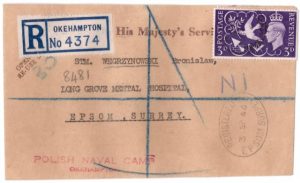
A letter sent from the camp (Mike and Hilary Wreford collection)
Many letters were also exchanged.
This OHMS marked letter was posted from the Camp. The stamp at the bottom shows it was posted via the Okehampton Naval Camp Post Office.
POST-WAR
After the war, when the majority of hostilities were over, the training programme at the Naval Warrant Officers School continued until December 1946, and at the Holding Camp until March 1947. There were classes providing education for the wartime lieutenants, now released from German captivity by the Allied forces.
Skills in the use of mines and torpedoes were essential, as Polish warships were involved in Operation Deadlight: securing and destroying the unmanned German U-boats surrendered to the Allies after the end of the war in late 1945 and early 1946.
In addition, Polish ships participated in mercy missions, for example delivering Red Cross packets to the Poles liberated from German labour camps.
In the photograph below, Lieutenant Stanisław Olszowski can be seen standing sixth from the left. He was involved in training Officer cadets and former prisoners of war both at the Naval camp in Bickleigh and later in Okehampton.
After the war, Lieutenant Stanisław Olszowski was also responsible for employment at the Okehampton Resettlement Camp, training and preparing personnel for civilian life.
DISSOLUTION OF THE POLISH NAVY IN THE WEST
The Polish Navy in the West was dissolved on the 31st March 1947, following the post-Yalta decisions and the creation of the Provisional Government of National Unity back in Poland in June 1945.
Four months earlier on the 1st December 1946, the Naval Warrant Officers School was also closed.
THE POLISH RESETTLEMENT ACT OF 1947
The Polish contribution to World War II was outstanding, and led directly to the Polish Resettlement Act of 1947, which offered Polish service personnel the chance to build a new life in Britain.
After the war had ended, the naval base in Okehampton became a Resettlement Centre for Polish naval personnel who couldn’t return to Poland. Poland had become a Communist state, and was partly occupied by Russia. Troops loyal to the Polish government in exile were considered enemies of the new Polish state. They faced imprisonment or worse if they returned home.
Others could not return to their homes in the eastern part of Poland, which following the Yalta agreement was annexed by Soviet Russia.
LIFE AT THE RESETTLEMENT CENTRE
In early 1947, the Okehampton Resettlement Camp became a temporary home to those who decided to stay in Britain. Signing up to the Resettlement Corps signalled a new beginning to all those Poles who were unable to return home. Many were joined by their families as they prepared for a new life in the UK.
At the Okehampton Resettlement Camp the former naval personnel and their families were trained to live and work in Britain. They received English lessons, education on typical ways of life in the UK, and on-the-job training in whatever occupation they chose.
Enlisted men, depending on their pre-war status, were trained to work in agriculture, building, coal mining or unskilled jobs. Some officers with engineering or technical skills were trained for work in industry. Some of the time, they were sent away from the camp on work detachments, working as handymen, chefs, bakers or on building sites as labourers.
After retraining at the camp, a few Polish people remained in Okehampton while others settled elsewhere in the UK.
Below, former Polish sailors, Aleksander Szypko and Kazimierz Szypillo are out on the town during their stay in the Resettlement Corps in Okehampton in 1947.
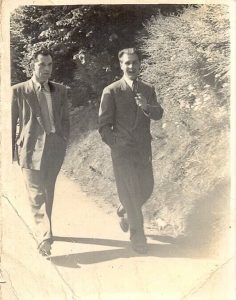
Aleksander Szypko and Kazimierz Szypillo out walking (Peter Szypko collection)
The Okehampton Resettlement Camp was finally closed in the middle of 1949.
CHRONOLOGICAL SUMMARY
To best illustrate the multifunctional role of the ORP Baltyk Naval Camp during its period of residence in Okehampton between 1944 and 1949, Peter Szypko prepared the following chart:
NEWSPAPER COVERAGE OF THE CAMP
A range of evidence about the Polish Naval Camp in Okehampton exists.
Newspaper clippings of the time reveal how the mix of different people might bring tensions: particularly during one infamous fight at the Market Hall. However, dynamics could also be very rewarding. The clippings reveal how different groups tried to facilitate the smooth running of the camp, and help to encourage acceptance and tolerance in the town – efforts which were recognised by the local community.
-

Newspaper clipping detailing a famous fight between Polish naval personnel and British airborne troops (Museum of Dartmoor Life collection)
MAKING PERMANENT HOMES IN THE TOWN
After the Camp closed, at least two Poles made permanent homes in the town: Peter Skrzypczak and Tony Smul. Both were keen footballers who represented the Polish Navy at football, and went on to play for Okehampton Argyle.
Peter was a regular for the Club from the late 1940s through to the early 1950s, and later worked there as a groundsman. He was regarded as “an acrobatic fullback”. His ability on the football pitch helped him to settle into the community.
The Mayor of Okehampton, Julie Yelland, kindly contributed to our research about the Polish people who settled in the local community after the war. She writes about Mr Peter Skrzypczak:
“Peter worked for W J Avery & Co Ltd in the early 70’s which is an Okehampton building company. Peter’s occupation was a Mason. In Devon, a Mason is a qualified general builder as opposed to a Stone Mason. My husband thinks that he may have had some connections to the steel or gas industry prior to that. Peter was married to an English girl and they lived in Simmons Way, Okehampton.” [….] My husband remembers Peter saying that he was based at the Nissan Huts at the site of the Rugby Club in the 1940’s and that he was born in Poland but lived in France prior to coming to the UK.”
Our project has also greatly benefited from contributions made by the local historian Mike Wreford. He writes about Tony Smul:
“Tony for a long time was the popular Head Waiter and much else at the White Hart Hotel, when they did high class banquets and dinners, and were a highly regarded venue. Tony I know played his part.”
Tony Smul also served the Okehampton Argyle Football Club for many years as an excellent goalkeeper.
Below is shown the programme for a football match dated the 15th November 1950, from Mike and Hillary Wreford’s collection. You can see Tony Smul representing Okehampton Argyle as a goalkeeper.
-

Okehampton Argyle match programme (Mike and Hilary Wreford collection)
-

Okehampton Argyle match programme (Mike and Hilary Wreford collection)
ACKNOWLEDGMENTS AND THANKS
Telling Our Stories Finding Our Roots is deeply indebted to all those who participated in our research and who have kindly shared their stories and experiences.
We hope that these findings will encourage further exploration, and that the community in Okehampton will be greatly enriched by this shared knowledge of our heritage.
Throughout my research I worked particularly closely with two project participants: Antoni ‘Tony’ Olszowski and Peter Szypko. Their contributions into the research were invaluable. I am deeply indebted to them for their support and for kindly sharing their stories, and the stories of their fathers.

